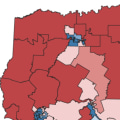As an expert in political campaigns and elections, I have closely observed the impact of third-party candidates on candidate campaigns in Southeast Texas. While the focus may often be on the top of the ticket, it is important to also pay attention to the local races happening in the region. These include positions in city councils, school boards, and state legislatures, where candidates from different parties are vying for votes.
The Role of Third-Party Candidates
While the majority of these races are between candidates from the two major parties, there are also third-party candidates in the mix. These candidates, representing parties such as the Libertarian Party and the Green Party, may not have the same level of name recognition or financial backing as their Republican and Democratic counterparts.However, they can still have a significant impact on candidate campaigns in Southeast Texas.Candidate campaigns in Southeast Texas often revolve around issues that are important to the region, such as energy production, hurricane preparedness, and economic development. Third-party candidates can bring fresh perspectives and ideas to these discussions, challenging the status quo and offering alternative solutions.
The Influence of Third-Party Candidates
One of the main ways that third-party candidates can impact candidate campaigns in Southeast Texas is by forcing their opponents to address issues that they may not have otherwise. For instance, a third-party candidate who is passionate about environmental issues may push their opponents to take a stance on renewable energy or conservation efforts. In some cases, third-party candidates may also siphon votes away from one of the major party candidates. This can be especially impactful in close races where every vote counts.For example, in the 2016 presidential election, third-party candidate Gary Johnson received over 4% of the vote in Texas, potentially taking away votes from both Donald Trump and Hillary Clinton. Moreover, third-party candidates can bring attention to important issues that may not be getting enough coverage in the mainstream media. By participating in debates and forums, these candidates can bring new ideas and perspectives to the table, forcing their opponents to address these issues as well.
The Challenges Faced by Third-Party Candidates
Despite the potential impact of third-party candidates on candidate campaigns in Southeast Texas, they face many challenges in gaining traction and winning elections. One of the biggest hurdles is the lack of name recognition and financial resources. Without the backing of a major party, it can be difficult for third-party candidates to get their message out to voters. Another challenge is the two-party system itself.In the United States, the winner-takes-all system means that a candidate needs to win a majority of votes to be elected. This can make it difficult for third-party candidates to gain enough support to win an election, as they often have to compete against well-established candidates from the two major parties. Furthermore, third-party candidates may face exclusion from debates and other campaign events, limiting their opportunities to reach voters and share their platform. This can make it even harder for them to gain momentum and compete with their opponents.
The Future of Third-Party Candidates in Southeast Texas
Despite these challenges, there is still hope for third-party candidates in Southeast Texas. In recent years, there has been a growing dissatisfaction with the two major parties and their candidates.This has led to an increase in support for third-party candidates, particularly among younger voters. In addition, with the rise of social media and other digital platforms, third-party candidates have more opportunities than ever before to reach voters and share their message. This can help level the playing field and give them a chance to compete with their opponents. Ultimately, the impact of third-party candidates on candidate campaigns in Southeast Texas will depend on the support they receive from voters. If more people are willing to consider alternative candidates and ideas, third-party candidates may have a greater influence on the political landscape in the region.
In Conclusion
While third-party candidates may face many challenges in candidate campaigns in Southeast Texas, they still have the potential to make a significant impact. By bringing new perspectives and ideas to the table, they can push their opponents to address important issues and offer voters more choices at the ballot box.As the political landscape continues to evolve, it will be interesting to see how third-party candidates shape the future of candidate campaigns in Southeast Texas.






